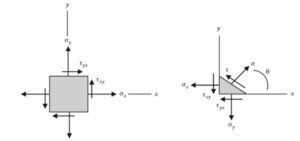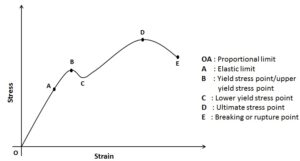To calculate Maximum Principal Stress is one of the basic step for the perfect designing of an engineering structure.
Generally, it had been a common approach to apply maximum principal stress to design a structure and calculating the break down or fracture caused by stress analysis method.
How to Calculate Maximum Principal Stresses?
The Maximum Principal Stress theory gives the idea of the root causes of failure in brittle materials. Depending upon this theory designer can decide the amount of loads which may be withstand by a structure.
Calculation of Maximum Principal Stress:
The normal and shear stresses act on a body in 3D is shown in the above figure.
σx,σy,σz are normal stresses .
τxy, τyx, τyz, τzy, τxz, τzx are shear stresses.
When the 3D element is in equilibrium, shear components become
τxy = τyx, τyz = τzy, τxz = τzx Eq(1)

In the above figure the stresses act on a stress element at an inclined angle θ can be calculated as follows:
σ = (σx+σy)/2 + (σx- σy)/2cos2θ + τxysin2θ Eq2
τ = – (σx- σy)/2sin2θ + τxycos2θ Eq3
Where the inclination angle θ is defined as
tan2θ = 2τxy/(σx- σy)
Or 2θ = tan-1 (2τxy/(σx- σy)) Eq4
To calculate the Maximum Principal Stresses eq 2 and eq 3 are differentiated wrt θ and set to zero to determine principal angle 2θ. Then Principal angles are substituted back into eq 2 and eq 3 to determine the principal stresses.
dσ/δθ = -(σx- σy) sin 2θ + 2τxycos2θ = 0
tan2θp = 2τxy/(σx- σy) or 2θp = tan-12τxy/(σx- σy) Eq6
Substituting Eq(6) back into Eq (2) and Principal Stresses are shown below:
Eq7
Now for maximum shear
dτ/δθ = -2(σx- σy/2) cos 2θ – 2τxysin2θ = 0
tan2θs = – (σx- σy/ 2τxy)
2θs = tan -1 – (σx- σy/ 2τxy) Eq9
Substituting eq (9) back into eq(3) and maximum shear stresses are
Eq10
Facts about Maximum Principal Stresses
According to Rankin failure or fracture of a component starts when the maximum value of principal stress exceeds the ultimate stress in a simple tension test.
The Maximum Principal Stress theory is one of the failure theories which mainly explain the causes of failure in case of a brittle material subjected with external loads.
Breakage or crack of a brittle material is always observed at a point where the highest value of Principal stress is equivalent to the ultimate strength. In other words we can say rapture starts at the extremely stressed point of the material.

If we consider a component which is acted upon by an external load, we get the stress strain curve as follows:

In the above stress strain curve, the highest value of stress(ultimate stress) is observed at point D and at point E fracture of the material starts. Up to point E the material only undergoes plastic and elastic deformation.
We can say as soon as the maximum value of principal stress of the material crosses the point D, failure occurs.
During designing one should always keep in mind that to overcome the situation of failure of a material, maximum principal stress value should be always below the ultimate stress (or yield stress)
Condition for failure of a material
Maximum value of principal stress>Ultimate stress
σ1 > σy or σul
The condition for safe designing of a component is the permissible stress or allowable stress should be greater than the maximum value of the principal stress acting on the body.
The ratio between the yield or ultimate stress and factor of safety is known as Permissible stress of a structure.
Permissible stress = σy or σul / F.O.S
The maximum principal stress failure predictor (MPSFP) design rule (Samuel and Weir, 1999) states that if a body made of brittle material undergoes a stress system where stresses are acted from multiple directions, damage will occur when maximum principal stress of the body is more than the local strength.
If we change the orientation of the stress element with any of the angle, we will get the stresses for that particular stress state. Now we will try to rotate the element with an angle which will give us the extreme values of the normal stresses.

System to new x’-y’ Coordinate System
Image Credit: ecourses.ou.edu
Here σn = (σx+σy)/2 + (σx- σy)/2cos2θ + τxysin2θ
δσx1/δσ = -(σx- σy) sin2θ + 2τxycos2θ
tan2θp = 2τxy/(σx- σy)
Substituting the value of θp ino the equation we can evaluate the extreme values of stresses. These stresses can be defined as σ1 (maximum) and σ2 (minimum).

at Principal Angle, θp; Image Credit: ecourses.ou.edu
Major Principal Stress,
Minor Principal Stress,
In general, the Principal Stresses σ1 and σ2 can be written as
± sign is the only difference of the stress equation which gives major and minor principal stresses.
Certain important points to be noted in Maximum Principal Stress Theory are:
Other name of Maximum Principal Stress theory is Rankine’s theory.
This theory is preferable for safe designing of brittle materials as brittle materials are weak w.r.t tension.
In case of a ductile material structure, Maximum Principal Stress theory is not preferred due to the possibility of shear failure in ductile material is high.
Under certain conditions this theory can also be applied for safe designing of ductile materials which are listed below:
1. Uni axial state of stress
2. Biaxial state of stress in case of like principal stresses
3. Under hydrostatic stress

I am Sangeeta Das. I have completed my Masters in Mechanical Engineering with specialization in I.C Engine and Automobiles. I have around ten years of experience encompassing industry and academia. My area of interest includes I.C. Engines, Aerodynamics and Fluid Mechanics. You can reach me at